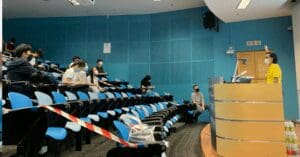
Education Workforce Trends: How Districts and Schools Are Evolving in 2025
Blog Post Popular Posts Author Kassidy Kinner Linkedin Kassidy, Digital Advertising Manager at Agile Education Marketing, brings a unique
The educational landscapes of inner city and rural schools can seem worlds apart, as each faces unique challenges that shape their environments. These differences influence everything from school budgets to purchasing decisions. For businesses operating in the education sector, understanding these distinctions is crucial to achieving enduring results.
Read on for a closer look at these two distinct school settings, exploring how socio-economic factors shape their school funding sources, student populations, and top purchasing priorities. This includes actionable strategies to enhance your outreach in both urban and rural communities.
An inner city school is located in the heart of a large city and typically serves students from nearby urban neighborhoods. These schools often reflect the area’s cultural and ethnic diversity, with students coming from a mix of socioeconomic, racial, and linguistic backgrounds. As part of the public school system, they’re shaped by the unique dynamics of city life.
A rural school is located in a small town or countryside area, often serving students across wide geographic regions. These schools tend to have smaller student populations and close-knit communities, with students sharing similar cultural or regional backgrounds. Also part of the public school system, rural schools reflect the pace and priorities of the communities they support.
Inner city and rural schools both strive to deliver quality education, but they face different realities when it comes to funding, resources, student demographics, academic performance, and day-to-day operations. Here are seven key ways these school systems stand apart:
Inner City Schools:
Located in densely populated urban areas, inner city schools serve diverse student populations, including many from minority backgrounds and low-income families. These students often face challenges such as trauma and limited access to healthcare and support services. The National Center for Education Statistics reports learners in urban schools are also more likely to experience poverty, difficulty speaking English, and health and safety risks.
Rural Schools:
In contrast, rural schools typically serve smaller, more homogeneous populations. Students often come from tight-knit communities, but still experience socioeconomic struggles, particularly related to isolation and access to services. According to the Institute of Education Sciences, nearly one in five U.S. students attends a rural school.
Inner City Schools:
While many urban schools face budget limitations, they generally receive more state and federal funding than rural schools. However, that funding is often spread thin due to higher student populations and complex infrastructure needs.
Rural Schools:
Rural schools operate with less funding overall, often relying on local tax bases that generate significantly fewer resources. This translates to:
Inner City Schools:
The Department of Education reveals that urban students across the U.S. were 74% more likely to enroll in college than rural students, and 106% more likely to attain a bachelor’s degree. At the same time, urban students face several barriers that can impact academic outcomes, such as:
Rural Schools:
Academic achievement in rural schools is shaped by:
Inner City Schools:
Urban schools struggle with aging infrastructure, requiring substantial investment in repairs, heating/cooling, and classroom modernization. They also prioritize student safety and curriculum innovation.
Rural Schools:
Rural schools face issues such as:
Inner City Schools:
Despite higher populations, access to mental health support, after-school programs, and enrichment opportunities is often limited due to staffing and budget constraints.
Rural Schools:
Rural districts often lack specialized services for students with learning or behavioral needs, which can contribute to achievement gaps—especially among low-income students. Additionally:
Inner City:
Urban districts focus on:
Rural:
Rural schools prioritize:
The unique priorities and challenges of inner city and rural schools directly shape their decision-making. For education solution providers, understanding these differences is key to connecting with both audiences. Tailoring your outreach—whether it’s to meet the urgent needs of inner city schools or the practical constraints of rural ones—helps ensure your message lands. When solutions reflect specific needs, you’re better positioned to make a real impact.
Mastering strategic outreach in diverse school settings requires a nuanced approach tailored to each environment’s unique needs. Here are a few best practices for engagement with each of these public education communities:
Inner city and rural schools each have their own set of budget constraints and purchasing priorities that shape how education solution providers should reach out. While understanding and adapting to the needs of each landscape can be tough, comprehensive education data emerges as a powerful ally to guide your way. This data helps you craft targeted strategies that really hit home—making your outreach efforts effective and relevant across both inner city and rural schools.
That’s where Agile Education Marketing comes in. As a trusted ally in the education sector, Agile Education Marketing provides the education data and insights you need to navigate outreach with precision. With our help, you can tailor your omnichannel marketing strategies to resonate with educational leaders and decision-makers across inner city and rural settings.
Ready to get the best results from your education marketing? Contact us today.

McKenzie, Marketing Coordinator at Agile Education Marketing, is a social media and campaign coordinator with over six years of experience in marketing, branding, and design. Prior to joining Agile, she’s held various roles in creative advertising, coached volleyball and basketball, and taught art for one year in a rural school district. She earned her Bachelor of Fine Arts degree from Colorado State University-Pueblo.

Blog Post Popular Posts Author Kassidy Kinner Linkedin Kassidy, Digital Advertising Manager at Agile Education Marketing, brings a unique

Read on and unlock the secrets of higher education procurement, including insights and best practices to boost your marketing strategy in the sector.

Discover how traditional and non-traditional students are reshaping higher education, plus the opportunities this shift creates for education vendors.
We’re here ready to answer your questions! Share a little information with us below and one of our Agile experts will be in touch shortly.
We use cookies to give you the best online experience. Cookies keep our site secure and reliable. They allow us to personalize agile-ed.com to you and help us analyze how the site is used.